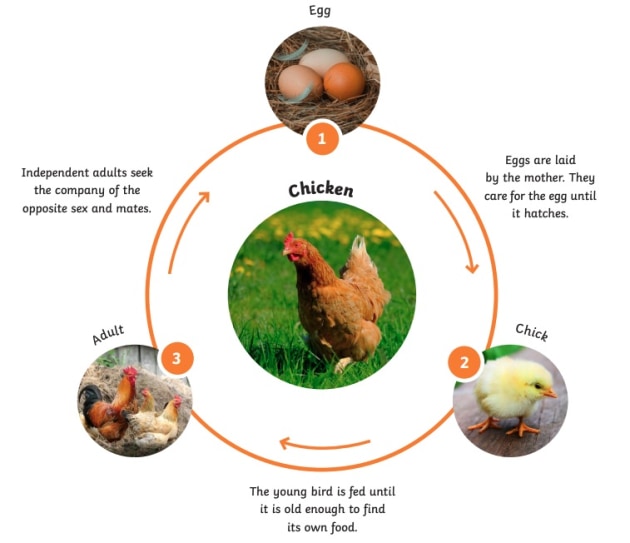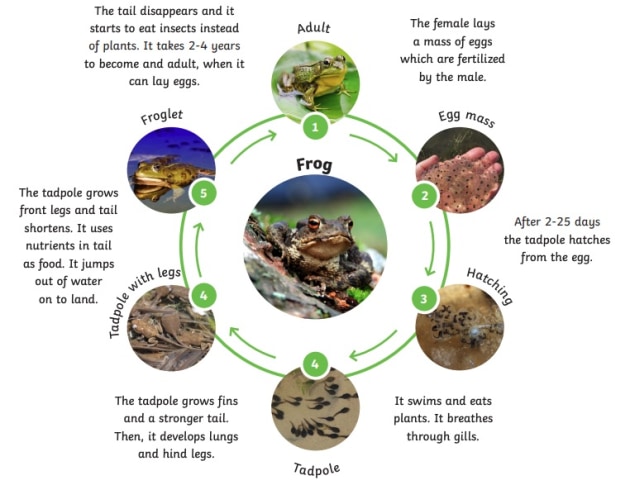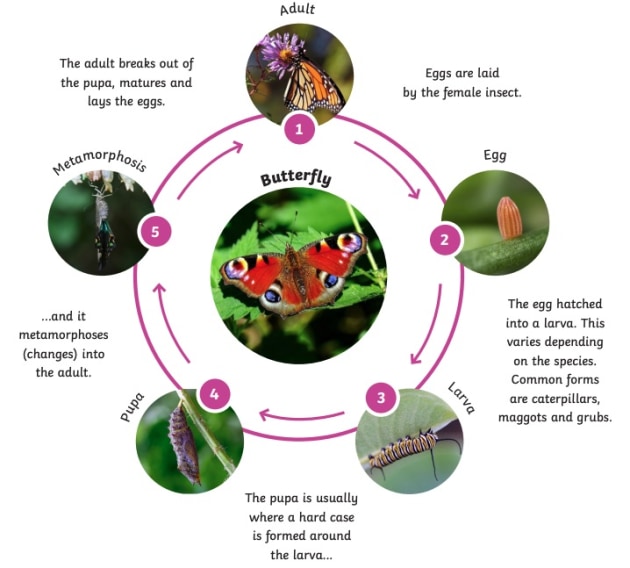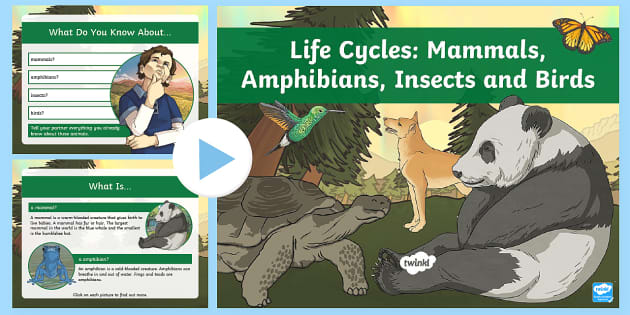
What is a Life Cycle?
Life Cycle

What is a Life Cycle?
A life cycle is the different stages of life for a living thing. All animals, including humans, have a life cycle as all animals are born, grow, reproduce and die.
In science, it’s usually displayed as a circular diagram showing each stage in words and/or pictures. A life cycle is presented as a circle to show that seeds/offspring are created as part of the cycle.
Examples of Life Cycles
The Bird Life Cyle

The Amphibian Life Cycle

The Insect Life Cycle

The Plant Life Cycle
Here's a quick run down of the life cycle of a plant:
Seed
First of all, we start with a seed. A flowering plant forms a seed when an egg cell is fertilised by pollen, to protect the plant embryo inside until the seed is in the right place to grow.. Once this has been done, the plant spreads its seeds so that they can find new places to grow, although we'll go into this process in a bit more detail later on
As well as the plant embryo itself, seeds usually contain different parts to help keep the embryo alive until it's grown enough to start producing its own food, including a food source for the plant to begin its journey, the beginnings of a root structure, and a protective outer shell called the seed coat.
Seeds can vary dramatically in size: from the seeds of tropical orchids, which are nearly invisible to the human eye, to avocados and coconut palms which have really large seeds - it depends a lot on the plant itself. If a plant needs a lot of food to germinate, then the seed will need to be much bigger.
Some seeds, such as the lotus, can lie dormant for many years and still sprout when conditions are right. Others, like some annual grasses, must sprout within a few weeks, or the plant embryo will run out of food and die.
Germination
When conditions are right, the seeds germinates, which simply means that it begins to grow. While different seeds require different conditions to germinate, seeds generally require water and warmth. Some seeds also require light, others must go through fire or even the digestive tract of an animal to begin their germination (Gross but true!). Many plants will develop their seed dispersal tactics to help support this process - plants that require fire to germinate their seeds might have seed pods that only burst and release their seeds when exposed to fire, or plants that need to pass through an animal's digestive tract may develop sweet-tasting fruit to tempt animals to eat them.
Germination begins when, under the right conditions, the seed absorbs water, and the embryo inside swells, breaking the seed coat. It then grows a tiny root called a radicle which anchors the plant and absorbs water. With this in place, it sends a shoot (plumule) that eventually sprouts above ground. When this happens, it is called a seedling.
Growth
The plant now begins to grow. The first leaves of the seedling are called cotyledons. These are actually not proper leaves, but nutrient stores that were present in the seed with the embryo. These nourish the plant as it develops the capacity to harvest nutrients from its environment. Some plants, called monocotyledon, have only one cotyledon while others, called dicotyledons, have two. These cotyledons have to keep the plant alive while in the seed and while it's developing proper leaves, so it's extremely important that they aren't damaged!
The plant then begins to develop its first proper leaves, called primary leaves. These leaves start the process of photosynthesis, or turning the energy from sunlight, water, and carbon dioxide into sugars that the plant uses for food. The plant does this by using chemicals called chloroplasts.
Many plants continue to grow upwards and form new leaves at the top of the stem (meristem), as well as downwards, growing more root hairs. This growth increases the amount of nutrients it is able to gather and helps it withstand weather, disturbance from animals, and competition from other plants.
Reproduction
Once the plant is fully grown, it's ready to begin the reproductive stage of its life cycle! During this stage, the plant flowers, is fertilised, and produces seeds.
At the beginning of the reproductive stage, the plant grows a small bud. Inside the bud, a tiny flower begins to form, protected by the surrounding sepals. Eventually, the bud opens to reveal a mature flower which is the reproductive part of the plant. Flowers usually have brightly colored petals or strong scents to attract pollinators.
The male part of the flower is called the stamen, and the female part is called the pistil. Some plants have both parts in the same flower, while others have only a male or female part per flower. The stamen carries pollen on the anther, a tiny pouch, which is supported by long filaments. The pistil has three parts: the stigma, which stands out as a sticky structure to trap pollen, the style, which is a tube that holds the stigma, and the ovaries, where the plant's eggs are stored and where seeds form. Once the flower itself has formed, the plant is ready for pollination
Pollination
Pollination occurs when the pollen from the male anther is transported to the mature female stigma. Some plants can self-pollinate. Others require insects, wind, rain, birds, and other natural processes to transport the pollen. Once the pollen comes into contact with the stigma, it grows a long pollen tube that carries the male sex cells to the plant's ovaries to fertilise them.
Plants can also cross-pollinate, which means pollen from one plant is taken to another plant of the same species. This is beneficial because it creates genetic diversity, which makes the subsequent generations stronger and more adaptable. Insects like bees play an important role in pollination, pollinating plants as they collect pollen for their food.
Seed Dispersal
After pollination, the seeds become reproductively viable. A protective layer, called the fruit, forms around the seeds. Some fruits are large and fleshy like an apple, others are dry, like the white parachute of a dandelion.
Seeds can be dispersed in many different ways. The simplest way is to fall to the ground, but this can lead to the seeds being too close to their parent plant and not being able to thrive. Many are eaten by birds and animals and transported somewhere new in their digestive tracts. Others, like burdock, are structured to stick to passersby. Still others, like dandelion, float easily on the wind over long distances.
The goal of all plants is to create new viable offspring, either through seed dispersal as we've described here, or through the dispersal of asexually produced offspring. Once the seed arrives at a place where it can germinate, the life cycle is ready to begin again!
The Mammal Life Cycle
The life cycles of animals are often extremely varied in form, but they all have four major phases:
Gestation and Birth
At this stage, the juvenile animal develops from an egg cell to the point where it can support its own basic life functions independently.
Animals can gestate in several different ways, and most of them fall into one of two key categories. Viviparous animals have structures inside their bodies that allow the female parent to protect and support the development of baby animals inside their own body, and then give birth to live young. Oviparous animals, on the other hand, lay external eggs which allow the young to survive outside their mother's bodies.
Until the juvenile animal either hatches from their egg or is given birth to by its mother, it's referred to as an embryo. Some species take a very long time to gestate - elephants carry their developing young inside them for 22 months! - whereas for others, like insects, it can be as little as a few days for the new animal to be ready to take on the world!
Growth
Before reaching sexual maturity or adulthood, animals pass through a growing stage.
Some species, most commonly invertebrates and amphibians, go through metamorphosis during the growing period. Metamorphosis includes larval and pupal stages. Butterflies, grasshoppers, mosquitoes, frogs and salamanders are some examples of animals that undergo metamorphosis. Hormones, such as somatotropin, induce growth in animals.
Many larger animals will have quite long childhoods where they still need some protection from their mothers and help to learn vital skills for surviving in the wider world. Orangutans stay with their mothers for 9 years, for example.
Reproduction
Once the animal has grown to full physical maturity, it's time for it to reproduce and produce offspring of its own. Like plants, animals can either reproduce sexually or asexually, but the vast majority of animals reproduce sexually. They do this in an enormous variety of different ways, ranging from internal fertilisation to laying huge clouds of eggs that males then release sperm into to fertilise, to even giving females a package of sperm that they can use to fertilise themselves!
Death
For many animals, after they've reproduced, their life cycle is at an end. For other animals that have a longer window of time when they're fertile and can have multiple offspring or litters of offspring throughout their lives, this waning will happen when they're too old to be viable for reproduction, but it's common to all animals.
As we age, we begin to experience loss of hearing and sight, lack of energy, body weakness and illnesses, all of which often precede the natural death of an animal in the wild. Predators are more likely to die natural deaths, while prey species are likely to succumb to attack when they become too old to defend themselves properly.
Different species have distinct lifespans. Among birds, parrots have the longest lifespans, living up to 100, while hummingbirds generally die before they reach 10 years of age.
Home learning activities you can do with your child to teach life cycles
- Grow fruit, vegetables and/or flowers from seeds
- Visit a farm park to observe animals with their offspring
- Cut pictures out of magazines or newspapers and create your own life cycle diagram
- Visit a garden centre and look at the seeds and plants at different stages of growth
- Look through family photo albums and make your own life cycle diagram with images of
family members at different stages of their life
Life Cycle Facts
- Unlike almost every other animal on the planet, the seahorse has shifted traditional sex-roles and it’s the male that “gives birth”! After an extensive courtship, involving colour changes and swimming displays, the female deposits her eggs in the male's pouch or oviduct, which he fertilises. As up to 2500 eggs develop inside him, he dramatically increases in size before firing out tiny offspring into the ocean. The young are then left to fend for themselves as the father focuses on the next brood.
- Kangaroos have extremely short gestation periods - even the biggest species of kangaroo only has a 33 day gestation period. Because of this, when kangaroo joeys are born, they're absolutely tiny! When they're born, a joey is little more than a tiny, blind, pink, hairless blob with just two rounded stumps for feet. In this underdeveloped state, the baby then has to clamber up through its mother's fur and into her pouch where it can feed. It then stays in the pouch and develops for around six months.
- The 17-year cicada is identified as such because it lives underground for that period of time, slowly developing into their adult forms while feasting on tree sap. Then, every 17 years, all of these cicadas emerge at once to reproduce and live for... just a few weeks.
- Some species come up with some really strange tactics to make sure they get to reproduce! When certain angler fish sub-species mate, the male bites into the female and essentially becomes a parasite. The male fuses with the female's body, to the point where all that remains of him are his sex organs, which are ready to fertilize the female's eggs when she ovulates. This mating strategy has evolved for deep sea life, where it's rare to come across a member of the opposite sex.
- Although everyone thinks of mammals as giving birth to live young, there's one group that doesn't! There are 5 species of egg-laying mammals, known as monotremes, that are currently alive: the duck-billed platypus and 4 species of echidna.
Resources to learn more about life cycles
At Twinkl, we have a variety of resources to help your students learn all about life cycles. All our resources are made in accordance with the Australian Curriculum so that you can teach your lessons with confidence and ease. To learn more about life cycles, be sure to check out:
For a variety of resources to use when teaching your students about life cycles, be sure to check out our The Cycle of Life Year 4 Integrated Unit for Australian Teachers. This collection of resources was compiled to help aid teachers as they create and teach their lessons concerning life cycles. From worksheets to activities to banners, these resources will be a fantastic addition to your lessons and help your students get the most out of their learning!
Our Animal Life Cycles PowerPoint is a great teacher-made resource to help your students learn about life cycles of various species such as mammals and amphiabians. Use this PowerPoint to either introduce your students to these cycles or to help cement their understanding of them.
Get your students excited to learn about life cycles with this Cycle of Life Banner .By incorporating banners and posters into your classroom, your students will be able to become fully emmersed in the topic and bring the theme into the classroom!
Educational Video
Watch this lovely reading of the Twinkl Original book The Cautious Caterpillar to engage children with the topic in a fun way.
 Home
Home  Membership
Membership  TwinklCares
TwinklCares  Create
Create  Blog
Blog 






















